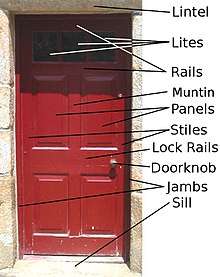Jamb
A jamb (from French jambe, "leg"),[1] in architecture, is the side-post or lining of a doorway or other aperture. The jambs of a window outside the frame are called “reveals.” Small shafts to doors and windows with caps and bases are known as “jamb-shafts”; when in the inside arris of the jamb of a window they are sometimes called "scoinsons."

A doorjamb, door jamb (also sometimes doorpost) is the vertical portion of the door frame onto which a door is secured.[2] The jamb bears the weight of the door through its hinges, and most types of door latches and deadbolts extend into a recess in the doorjamb when engaged, making the accuracy of the plumb (i.e. true vertical) and strength of the doorjambs vitally important to the overall operational durability and security of the door.
The word jamb is also used to describe a wing of a building, perhaps just in Scottish architecture. John Adam added a 'jamb' to the old Leith Customs house in the Citadel of Leith in 1754–1755.[3]
See also
References
| Wikimedia Commons has media related to Jambs (architecture). |
| Wikisource has the text of the 1911 Encyclopædia Britannica article Jamb. |
- Merriam-webster.com
- Nikolas Davies, Erkki Jokiniemi (2012). Architect's Illustrated Pocket Dictionary. Routledge. p. 262.
- Edinburgh City Archives. Dean of Guild Court papers, warrant granted to John Adam on 27 June 1764 when he presented a full set of building accounts.